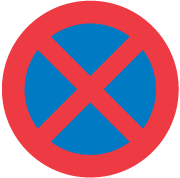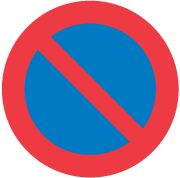



Parking is any stopping of the vehicle with or without driver for at least three minutes. However, if you stop for more than three minutes to drop off passengers or to collect passengers, or to load or unload goods, this is not considered as parking in terms of the Road Traffic Act.
Stopping is any stopping of the vehicle with or without driver for three minutes at the most. If you have to stop in congested traffic or as part of a manoeuvre, this is not considered as stopping in terms of the Road Traffic Act.
Stopping and parking may not occur in such a place or in such a way that causes danger or inconvenience to the traffic.
Stopping or parking may only occur on the right side of the road in the direction of the traffic. On less busy roads and roads with one-way traffic, stopping or parking may, however, occur on the left side. When stopping or parking, the vehicle must be brought into the longitudinal direction by the outer edge of the traffic lane or, if possible, out of the traffic lane. When stopping or parking in a parking space, that is outside of a dense built-up area and placed in immediate connection to the road, the driver must , if possible, make use of the parking space that is located to the right of the direction of traffic.
Stopping or parking may not occur on cycle paths, pedestrian paths, outer verge or pavement. The same applies to the central reserve, traffic islands and similar. Outside of dense built-up areas a vehicle can, if the allowed gross weight does not exceed 3,500 kg, stop or park with all of or a part of the vehicle on the outer verge or with a part of the vehicle on the pavement. The first point does not apply to bicycles or two-wheeled mopeds.
When the driver leaves the vehicle, it must be ensured that the vehicle cannot move by itself. The driver must also make the necessary provisions in order to ensure that the vehicle cannot be used by others without authorisation. A mandatory anti-theft device must be switched on. The Minister of Transport can determine the regulations on which type of locking devices must be used.
Opening of vehicle doors, boarding or disembarking and loading and unloading must occur in such a way that danger or unnecessary inconvenience is not caused.

The sign forbids stopping on the traffic lane, which does not occur in consideration of the rest of the traffic. The more detailed content of the regulation may be indicated on the plate below the No Stopping sign. For example, it may be indicated that No Stopping only applies to certain weekdays or within a certain time and that outside of these restrictions there may be no parking or time-limited parking.
Where the regulations in Section 28, item 1 or Section 29 of the Road Traffic Act are more restrictive than the regulations indicated on these signs, the law takes precedence.
The regulations indicated on the mentioned signs apply only to the side of the road on which the signs are situated. Thus, no change occurs in the rule in Section 28, item 2 of the Road Traffic Act.
The regulations apply to the driving direction on the side of the road where the sign is situated up to the next junction, unless another sign is situated before the junction for stopping or parking or something else is indicated with an arrow on the plate below.

The sign forbids parking on the roadway. The more detailed content of the regulation may be indicated on the plate below the No Parking sign. For example, it may be indicated that No Parking only applies to certain weekdays or within a certain time and that outside of these restrictions there may be time-limited parking.
Where the regulations in Section 28, item 1 or Section 29 of the Road Traffic Act are more restrictive than the regulations indicated on these signs, the law takes precedence.
The regulations indicated on the mentioned signs apply only to the side of the road on which the signs are situated. Thus, no change occurs in the rule in Section 28, item 2 of the Road Traffic Act.
The regulations apply to the driving direction on the side of the road where the sign is situated up to the next junction, unless another sign is situated before the junction for stopping or parking or something else is indicated with an arrow on the plate below.
Stopping or parking may not occur:
Parking is not allowed:
Be ready for the theory test
You will have access to more than 1,000 multiple choice options. Our theory tests have been tested on more than 140 students before we launched it. Everyone passed the first time.
If the vehicle is stopped or parked on a lane that is on a road, berth or similar, or within 2 metres from the nearest track, the driver may not be further from the vehicle than the driver can, at all times, be aware of any traffic on the track. When it can be seen or heard that a train or other vehicle on the track is approaching, the driver must remove his vehicle without being asked to do so.
If, due to a traffic accident, engine failure or for another reason, the vehicle is stopped in a place where stopping or parking is prohibited, the vehicle must be moved as soon as possible to a suitable place unless otherwise stated in the regulations in Section 9 (Obligations in the event of traffic accident). If the vehicle is stopped in such a place or in such a way that it is a danger or inconvenience to traffic, the driver must take the necessary precautions to warn other road users if the vehicle cannot be removed immediately. Motorized vehicles, except for two-wheeled mopeds and bicycles without side-car, as well as trailers must be marked with a triangle warning device. This must be positioned so road users who are approaching are warned in good time. The Minister of Transport determines detailed rules about the warning device and its positioning.
If the vehicle is stopped on a railway crossing or other crossing, the driver must also take such precautions that are necessary to warn drivers of trains and other railway vehicles if the vehicle cannot be moved immediately.
Take a 12-question subject test - requires Platinum access.